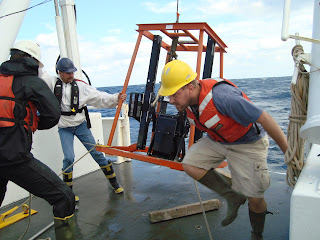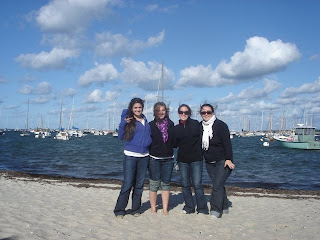Greetings! In August of 2008, the WSU Mercury Team participated in a two-week long, oceanographic research cruise. During that time, we had the opportunity to blog about our experiences. We soon will embark on
another two-week long research cruise at the end of September 2009 and blog about our discoveries once again!
The scientific purpose of this cruise is essentially the same as the last cruise. For those of you who are just joining in to follow along with our blog, here is a description of the purpose of the cruise. For those of you who followed us last year, you will realize that this is an excerpt from our first blog. The purpose of our research is, "to study the biogeochemistry of mercury in the oceans. Like many things about our oceans, not much is known about the behavior of mercury. Since the 1990s, a significant amount of research has been conducted on mercury and a lot of progress has been made in perfecting sampling procedures, improving detection limits and increasing our understanding of its cycling in the environment. In fact, many freshwater ecosystems, the atmosphere above the Arctic, terrestrial systems, and some coastal environments have been studied. However, not much is known about mercury in the oceans. This is ironic, because, as most of you recognize, the main route of human exposure to mercury is via the consumption of fish and, yet, the majority of the fish we consume globally is derived from the oceans! Clearly, studying what happens to mercury in the oceans is an integral part of understanding potential human exposures to mercury."
Since the August 2008 cruise,
some amazing advancements have been made in our field. For example, our advisor, Dr. Chad Hammerschmidt, improved the detection limit for measuring methylmercury (MMHg; an organic form of mercury that accumulates readily in humans and other organisms) in seawater to 2.0 fM. As part of the NSF funded "GEOTRACES" program, Dr. Hammerschmidt and his students measured MMHg at much lower levels than previously achieved. This allows us to see new trends and provides new insight into how mercury is cycling in the oceans. We also analyzed some of the data collected on the August 2008 cruise and much of that information has been used to improve our plans for the present cruise.
Right now, we are packing all of the materials we will need for the research cruise. We have been washing bottles, finishing important analyses, and making sure that all of our supplies from last time are in prime condition. Surprisingly, this year seems more hectic than the last! But, I think there is
even more excitement in the air than last year!
As time gets closer, we will post about who is conducting research on the cruise, where we will be traveling in the northwest Atlantic, what the research vessel looks like, etc.
We look forward to sharing our experiences with you!
~Lisa
 Hg Team of scientists. From Left to Right, bottom row: Dr. Geraldine Nogaro, Katlin Bowman, Lisa Romas, Melissa Tabatchnick, Michael Finiguerra, Kathleen Munson, Susan Gichuki. Left to right, top row: Dr. Carl Laborg, Dr. Chad Hammerschmidt, Tristan Kading, Allan Hutchins, Lynne Butler, Dr. William Fitzgerald, Prentiss Balcom. Absent - Jenay Guardiani Aunkst.
Hg Team of scientists. From Left to Right, bottom row: Dr. Geraldine Nogaro, Katlin Bowman, Lisa Romas, Melissa Tabatchnick, Michael Finiguerra, Kathleen Munson, Susan Gichuki. Left to right, top row: Dr. Carl Laborg, Dr. Chad Hammerschmidt, Tristan Kading, Allan Hutchins, Lynne Butler, Dr. William Fitzgerald, Prentiss Balcom. Absent - Jenay Guardiani Aunkst.
 Jenay packing.
Jenay packing. Melissa packing up her room.
Melissa packing up her room.











 Just before sunrise...
Just before sunrise... The sun creeping up in the sky to begin the day...
The sun creeping up in the sky to begin the day...
















